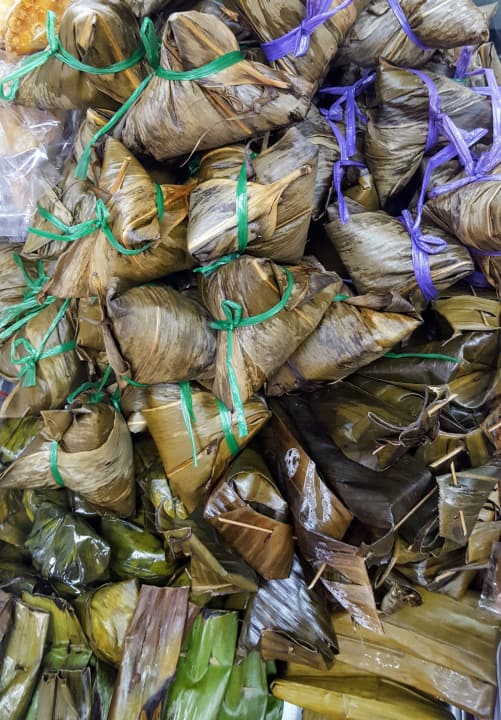



Singapore. Glitzy skyscrapers and futuristic attractions. A vibrant food scene. Endless shopping. These are, undoubtedly, on the agenda for any traveller to the island nation. But Singapore also offers ways to delve into its multi-cultural history. Singapore’s population is a multi-ethnic blend of Chinese, Indian and Malay people. Neighbourhoods like Chinatown and Little India offer glimpses into its diverse culture. The country is also home to people of mixed heritage, most notably the Peranakan community.
 Parcels of kueh. (Photo by Malavika Bhattacharya)
Parcels of kueh. (Photo by Malavika Bhattacharya)
For many visitors to Singapore, the Peranakans are a little-known or unknown community. But their culture has influenced everything from food to design and architecture here. The origins of the Peranakan people date back to the 15th century, when early Chinese and Indian settlers on the island mingled with the local Malay or Indonesian population. The children of these unions formed the Peranakan community. Chinese-descendant Peranakans, also called Baba-Nyonya (man-woman), form the largest group here, but there are Peranakans of Indian Hindu and Muslim descent as well.
In a bid to learn about Singapore’s mixed heritage, I head to the east of the island, where the adjoining neighbourhoods of Katong and Joo Chiat preserve the legacy of the Peranakan people. Home to a sizeable Peranakan population in the 1900s, the area still retains its traditional architecture and vestiges of its age-old culture.
On a guided tour, Bhajan Singh of A+B Edu Tours brings me to Koon Seng Road in Katong. Before me, the road unfurls like a palette of paint swatches. Slender, pastel-hued structures line either side of the street in an orderly row. Uniform in design but painted in vibrant and contrasting shades of tangerine, salmon pink, and powder blue, the conjoined buildings offer a lesson in the art of colour blocking.
These are the famous shophouses of Koon Seng Road. Later, a Google search reveals that the road is often referred to as ‘the most colourful street in Singapore’.
Slowly, I pick out the intricate detailing on the frontages: shuttered windows with venetian blinds, floral-patterned tiles, butterfly-shaped windows, colonial-style columns, and ornate Chinese motifs of dragons and beasts.
“'Peranakan’ means a child of mixed heritage. It comes from the word ‘anak’, meaning ‘child’ in Malay,” Bhajan Singh says. Other definitions translate ‘peranakan’ as ‘local born’.
Traditionally, the shophouses accommodated businesses on the lower level, with residences on the upper floor. “The Dutch imposed a tax on the width of the entrances”, Mr Singh says. As a workaround, the shophouses were built to be narrow but deep, with cavernous interiors and courtyards. “Furniture had to be hauled up through the windows as it wouldn’t fit through the entrance.”
The cluster of residences along Koon Seng Road dates back to the pre-war era in the early 1900s, and their heritage status ensures they are the best maintained. Coffee shops, grocery stores, restaurants, and even hostels occupy the other ornate buildings scattered through the area.
As I wander through the lanes, I notice a mix of Chinese, Malay, and Indian influences. Across the street from a mosque, at the Sha Zah Confectionary, I bite into a sardine-and-onion-filled semi-circular pastry with crimped edges, strongly resembling the Indian gujia. A tangy burst of flavour follows. The crescent shape of the epok-epok was influenced by the Portuguese, who came by the way of Goa, Mr Singh tells me.
Foreign influences are everywhere, and for a Singapore dollar each, I load up on Indian-style triangular mutton samosas and British-influenced square beef curry puffs. At the tiny but famous Kway Guan Huat, I watch as thin sheets of wheat flour are hand-rolled to make traditional Chinese popiah skins – the outer wrap for popiah or spring rolls.
Further down, on Joo Chiat Road, stands the ornate Kuan Im Tng Chinese temple, dedicated to Buddhism, Taoism and Confucianism. Amidst the grocery stores and fair price shops with swathes of fabric and cane kitchenware, tiny shops sell brightly embroidered kebayas (blouses) and sarongs, the traditional combination worn by Nyonya women. The Joo Chiat neighbourhood is also home to the Guan Hoe Soon restaurant, an old institution serving authentic Peranakan food.
I hop across to the Geylang Serai food centre, crammed with Malay and Peranakan offerings. Lunch is a traditional Peranakan bowl of coconut-flavoured laksa, followed by colourful kueh (sweet snacks) made with coconut and rice flour. The individual flavours are familiar, yet the resulting taste is entirely new, just like Singapore’s multifaceted Peranakan culture.
 In Joo Chiat, Singapore. (Photo by Malavika Bhattacharya)
In Joo Chiat, Singapore. (Photo by Malavika Bhattacharya)
What to see and buy
SEE: The Peranakan Museum on Armenian Street houses traditional crafts and artefacts, and offers an insight into Peranakan culture. Tickets are SGD 12.
SHOP: Kim Choo Kueh Chang is a cozy little shop selling traditional food items like nyonya-style rice dumplings and boxes of kueh.
TOUR: Along with visits to other parts of Singapore, the Makan Makan – Let’s Eat tour by A+B Edu Tours and Travel Pte Ltd offers a glimpse into East Singapore’s Peranakan cuisine and culture. Prices depend on group size and available on request. (http://www.abedutours.com.sg/; nanak@abedutours.com.sg)
Discover the latest Business News, Sensex, and Nifty updates. Obtain Personal Finance insights, tax queries, and expert opinions on Moneycontrol or download the Moneycontrol App to stay updated!
Find the best of Al News in one place, specially curated for you every weekend.
Stay on top of the latest tech trends and biggest startup news.